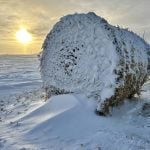Reuters — La Niña has ended and neutral conditions are expected to continue through the Northern Hemisphere’s spring and early summer 2023, a U.S. government weather forecaster said March 9.
El Niño could possibly form during summer 2023 and persist through the fall, they added.
“The forecaster consensus favours ENSO-neutral through summer 2023, with elevated chances of El Niño developing afterwards,” the National Weather Service’s Climate Prediction Center said. ENSO stands for El Nino Southern Oscillation.
The La Niña weather pattern is characterized by unusually cold temperatures in the equatorial Pacific Ocean.
Read Also

Predicting Manitoba winter snowfall
How much snow should farmers in Manitoba expect for the rest of December 2025 and into January-February 2026? Here’s what the weather models say about the winter to come.
There is an over 50 per cent chance of the El Niño weather pattern emerging by the July-August-September period, the forecaster said, as some regions braced for a hit to crop production.
The El Niño phenomenon is a warming of ocean surface temperatures in the eastern and central Pacific, sometimes causing crop damage, flash floods or fires.
“A weak monsoon, which has been observed in previous El Niño years, could lead to lower production of rice not only in India but across Southeast Asia,” said Mark Brusberg, chief meteorologist at the U.S. Department of Agriculture.
In Australia, the wheat crop is likely to face risks from dry weather due to the El Niño weather pattern in the second half of the year, while India’s weather office has warned that another heat wave in March is likely, especially in the key wheat-producing central and northern states.















